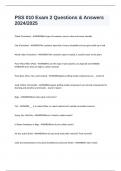PSS 010 Exam 2 Questions & Answers
2024/2025
Plastic (Container) - ANSWERSBest type of container; easy to clean and reuse; durable
Clay (Container) - ANSWERSThe container type that is heavy, breakable and can get a build up of salt
Wood Cedar (Container) - ANSWERSIf this container type is treated, it could be toxic to the plant
Peat/ Wood Fiber (Pots) - ANSWERSTo use this type of pot properly, you typically need ADDED
NITROGEN since they are high in carbon material
Peat, Bark, Moss, Cior, and Compost - ANSWERSOrganic potting media components are.... (name 5)
Sand, Perlite, Vermiculite - ANSWERSInorganic potting media components are mineral components for
draining and aeriation and include... (name 3 types)
Bogs - ANSWERSWhere does peat come from?
Coir - ANSWERS___ is a cookout fiber as a peat replacement; quickly renewable resource
Sunny, Dry, Mid-Day - ANSWERSWhen is it best to collect seeds?
In Paper-Envelopes or Bags - ANSWERSHow do you collect seeds?
Air dry, soak if dried - ANSWERSHow do you treat seeds after removal? Fruit removal?
Cold, Dry (temperatures; Dry, Dark (Conditions); Desiccant Packet - ANSWERSTo store seeds:
,-___, ___ temperature
-___, ___ conditions
-_________
Scarification of Seeds - ANSWERSSeed coat abraded; happens naturally from animals eating seed
(stomach acid etch the seed coat); can be done using file or sandpaper, rock tumbler, nail clippers
Stratification of Seeds - ANSWERSPeriod of cool and moist time like leaves that layer seeds in fall, winter,
and spring; can be done by placing the seeds in a ziplock, placing in sand, add water, and place in
refrigerator for 1-3 months
2-3; surface - ANSWERSWhen sowing seeds, they should be ___ times their diameter deep; they should
be watered gently and evenly, and light should be directly on the ___
prick-out the seedling, cotyledons - ANSWERSTo transplant seeds, you should ___ with a dibble, pencil,
or popsicle stick; Handle only by the ___, never the stem; Make hole in potting mix first then firm mix
around seedlings root after planting
- ANSWERSScoring the rootball
Cuttage - ANSWERSFor ___, the longer the cutting, the better
Softwood or Hardwood - ANSWERS___ Cuttage: 6-8" cutting length
Herbaceous - ANSWERS___ Cuttage: 3-5" cutting length
2 - ANSWERSThe minimum number of nodes required is ___
Factors affecting rooting - ANSWERSAge of stock plant (cone of juvenility),
Auxins,
Carbohydrates,
, Mineral nutrients of stock plant,
Presence of flower buds/flowers, proper moisture (in rooting medium and in surroudning atmosphere),
Light,
Temperature,
Wounding,
Time of year when cutting is taken
Deciduous (=fall/winter when dormant)
Narrowleaf Evergreens (=fall/winter when dormant like yew bush)
Broadleaf Evergreens (=summer when active like holly)
Herbaceous, Tip, Leaf-Bud, Leaf (limited to only a few plants like begonia and African Violet), Woody, -
ANSWERSTypes of Cuttings
Auxin - ANSWERSPlant hormone; Elongation of cells; Plant growth
Label - ANSWERSIt is important to __ when taking cuttings so that you do not mix up plants
Layerage - ANSWERSThe process of forming roots on a stem that is still attached to a plant
Renew, Direct Energy - ANSWERSPros of Layerage: __ an existing plant, ____ from mother plant
Limited Number, Disease - ANSWERSCons of Layerage: Results in a ____ of plants, __ can be transmitted
to new plant
Tip - ANSWERS___ Layering is when the tip of the shoot is inserted into the ground upside down; Often
done with raspberries and other brambles
Simple - ANSWERS___ Layering is done in the spring; 6" of the tip is exposed; Wired and staked; Used on
narrow-leaved evergreens




